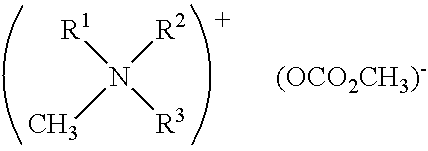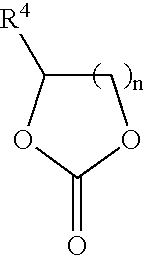In situ process for preparing quaternary ammonium bicarbonates and quaternary ammonium carbonates
a technology of quaternary ammonium carbonate and in situ process, which is applied in the field of in situ process for preparing quaternary ammonium bicarbonate and quaternary ammonium carbonate, can solve the problems of increasing the cost and efficiency of the process, increasing the cost of preparing quaternary ammonium carbonate by this process, and being very corrosiv
- Summary
- Abstract
- Description
- Claims
- Application Information
AI Technical Summary
Benefits of technology
Problems solved by technology
Method used
Image
Examples
example 1
[0058]The reactor was charged with 295 g (0.95 moles) didecylmethylamine (92% (w / w) pure and 8% (w / w) tridecylamine), 153 g (1.5 moles) propylene carbonate, and 177 g (5.7 moles) of methanol. The mixture was heated to 140° C. with stirring for 28 hours. Didecyldimethyl ammonium methocarbonate was produced.
[0059]Initially, the solution consisted of two phases. The top layer was essentially pure didecylmethyl amine. After 15 hours, the solution was a single phase. When a sample of the solution after 15 hours of heating was allowed to cool to room temperature, it became hazy and separated into two phases.
[0060]According to gas chromatography, about 90 to 95% of the didecylmethylamine was converted to didecyldimethyl ammonium methocarbonate after 15 hours of heating and about 99% of the didecylmethylamine was converted to didecyldimethyl ammonium methocarbonate after 28 hours of heating.
example 2
[0061]The reactor was charged with didecylmethylamine, propylene carbonate, and methanol at a molar ratio of 1:1.2:6.5. The mixture was heated to 130° C. for 16 hours. Didecyldimethyl ammonium methocarbonate was produced. Initially, the solution consisted of two phases. After heating, the solution remained in two phases. The top layer was high in tridecylamine.
[0062]According to gas chromatography, about 75-80% of the didecylmethylamine was converted to didecyldimethyl ammonium methocarbonate after the 16 hours of heating.
example 3
[0063]A reactor was charged with didecylmethylamine, propylene carbonate, and methanol at a molar ratio of 1:1.6:10. The mixture was heated to 130° C. for 20 hours. Didecyldimethyl ammonium methocarbonate was produced. Initially, the solution consisted of two phases. After 16 hours of heating, the solution consisted of one phase.
[0064]According to gas chromatography, about 85-90% of the didecylmethylamine was converted to didecyldimethyl ammonium methocarbonate after the 20 hours of heating.
PUM
| Property | Measurement | Unit |
|---|---|---|
| Temperature | aaaaa | aaaaa |
| Temperature | aaaaa | aaaaa |
| Temperature | aaaaa | aaaaa |
Abstract
Description
Claims
Application Information
 Login to View More
Login to View More - R&D
- Intellectual Property
- Life Sciences
- Materials
- Tech Scout
- Unparalleled Data Quality
- Higher Quality Content
- 60% Fewer Hallucinations
Browse by: Latest US Patents, China's latest patents, Technical Efficacy Thesaurus, Application Domain, Technology Topic, Popular Technical Reports.
© 2025 PatSnap. All rights reserved.Legal|Privacy policy|Modern Slavery Act Transparency Statement|Sitemap|About US| Contact US: help@patsnap.com



